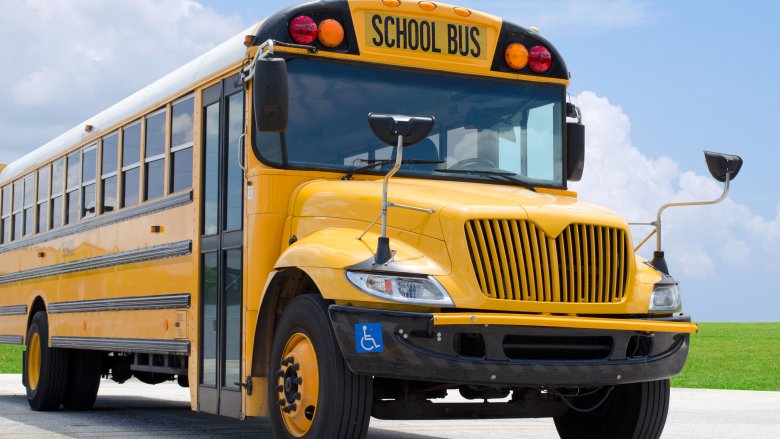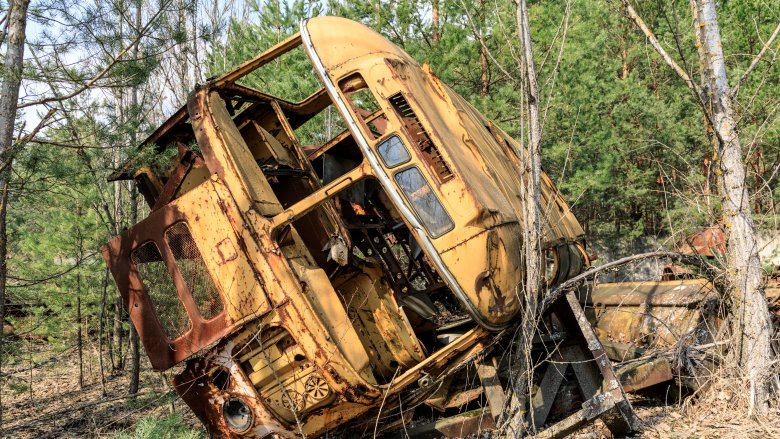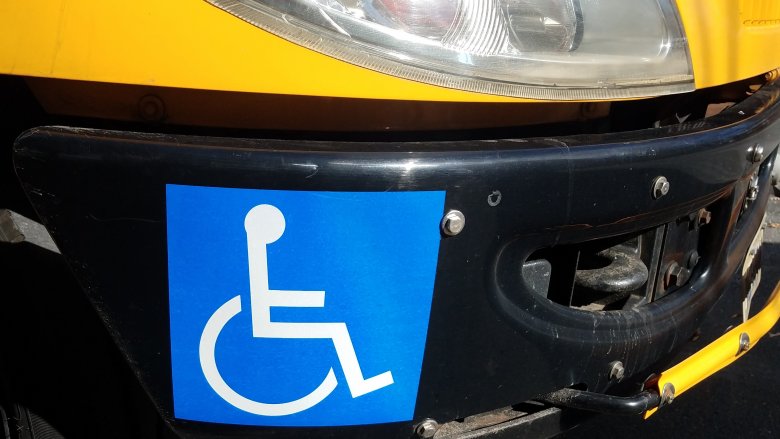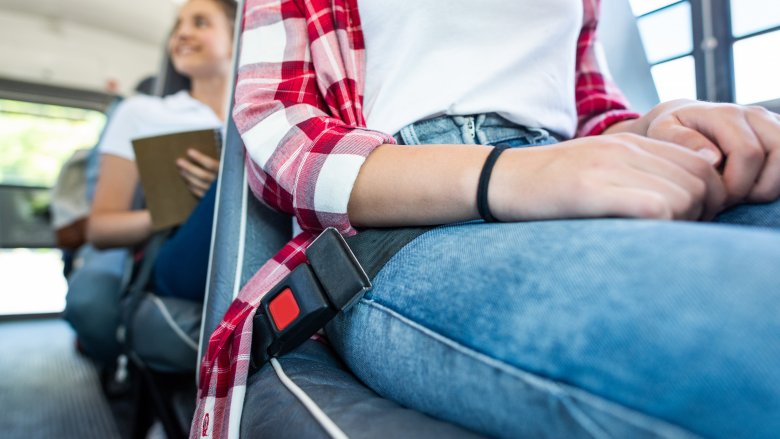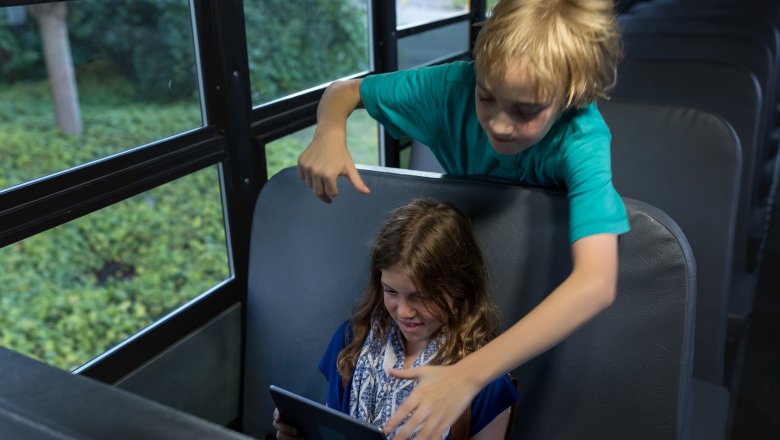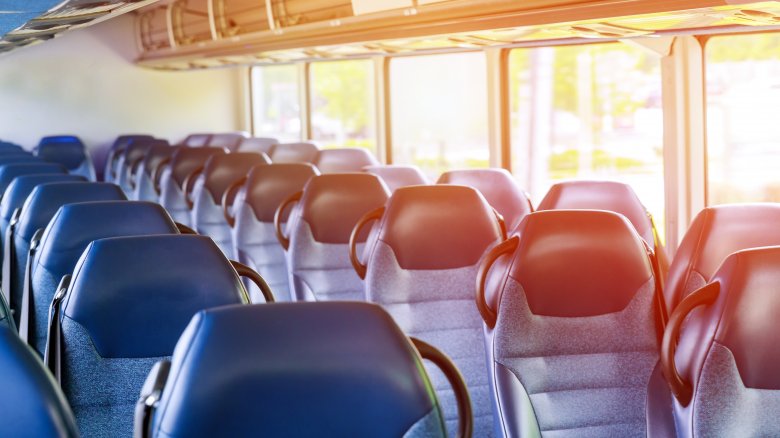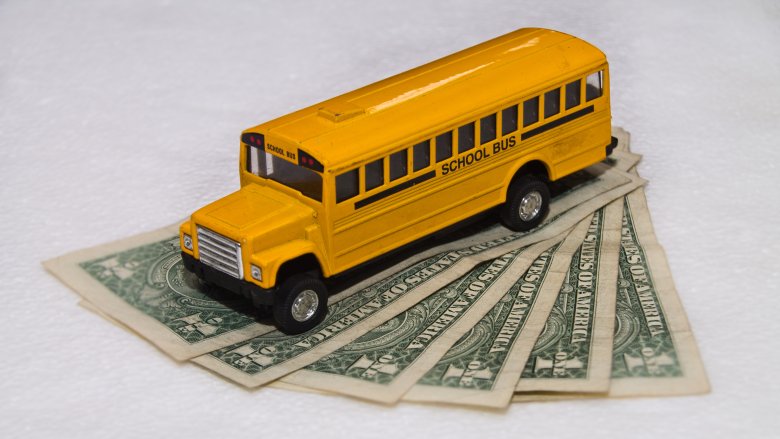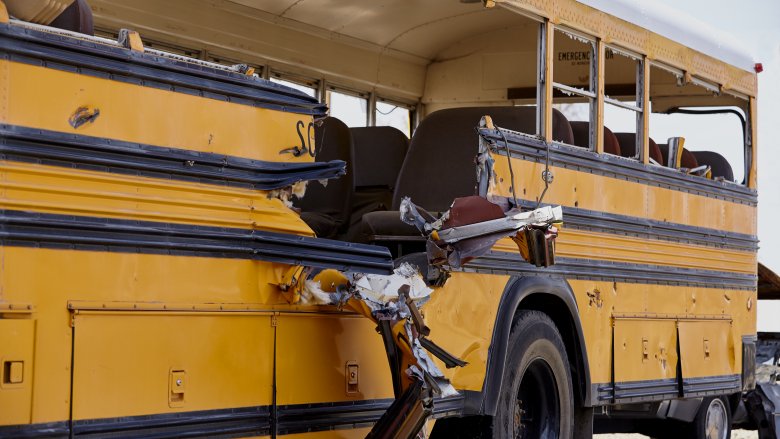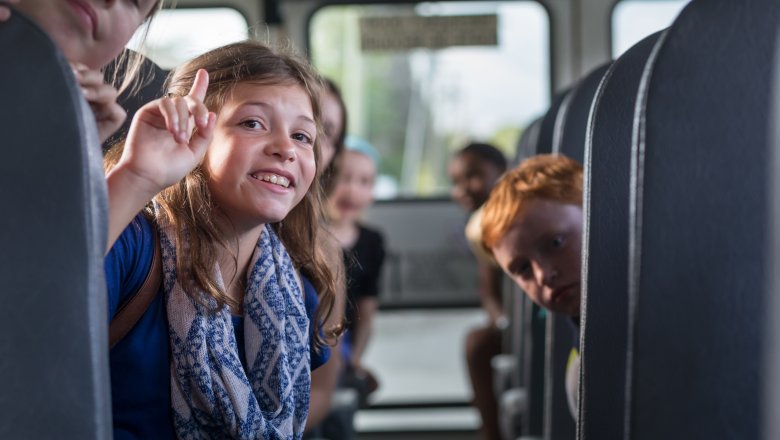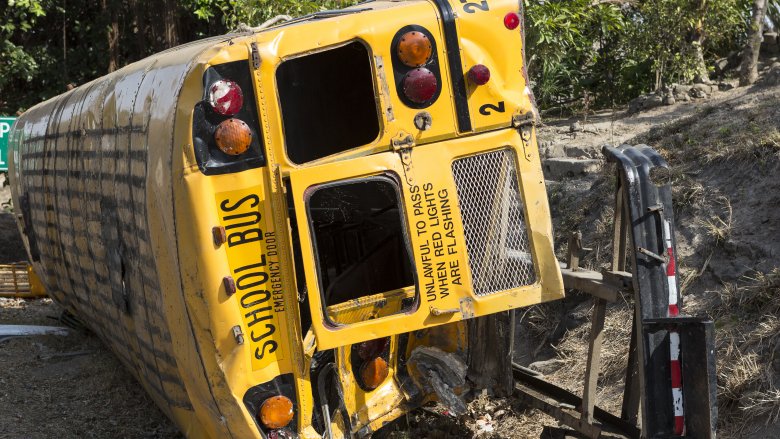The Real Reason Buses Don't Have Seatbelts
Face it, cars are pretty much just rattling death machines on wheels. Some people complain about seatbelts, but honestly, if you're ever unlucky enough to get in a traffic accident, you'll find that having that annoying strap buckled to your chest is great for ... well, not dying. That's kind of a big deal.
Everywhere you drive, people or things are constantly reminding you to buckle up, from police officers to the little beeping sound in your car. That's what makes it all the weirder that when kids get on a school bus, there are no seatbelts to be found. How is that legal? Don't they care about the children? Well, there are a number of reasons why seatbelts aren't deemed necessary on buses — whether for children or adults — and it's actually a rather feverish debate. Here are the details you need to know, regarding whether or not the kids are all right.
School buses are really, really safe
Considering that school buses are designed to carry children, parents should breathe a big ol' sigh of relief at the fact that, statistically, they are the safest vehicles on the road. Seriously, it isn't even close. These things are like yellow tanks, minus the weaponry. According to the National Highway Traffic Safety Administration (NHTSA), your kiddos are 70 times more likely to get to school, unharmed and smiling, when they take the school bus instead of your car. So, no matter how much you brag about your driving skills, the school bus is still a whole lot safer. Sorry, guys.
But how so? Well, it's because school buses are decked out in neat safety features like cross-view mirrors and flashing red lights. Plus, there's that infamous traffic law regarding how passing a stopped school bus is akin to throwing your driver's license into a bonfire. Buses are also heavier than cars, and distribute crash forces in a different way. The most important feature of all, though, is something called "compartmentalization," which is the leading safety feature of all buses today. Basically, this refers to how the seats are strong, closely spaced, and have raised, energy-absorbing backs. So when a kid does get flung forward, they safely bump into the tall seat in front of them, instead of being thrown through a window. At least, that's how it's supposed to work.
Today's buses are way safer than the ones your parents rode
Now, if your old man is busy guffawing at this whole compartmentalization thing, and is about to launch into one of his "back in my day" stories, stop him right there. The school buses on the road today have very little in common with the equally-yellow vehicles from before 1977. That's mainly because, well, those elderly school buses were about as safe as dropping a hammer on your skull and praying for the best.
As Indianapolis Monthly puts it, traffic accidents in pre-1977 school buses were — for the poor kids who rode them — the equivalent of "placing an egg in a toolbox full of wrenches and gasoline, then throwing it down a flight of stairs and hoping it came out unbroken." Jeez, talk about some nightmarish imagery. Anyhow, after these pre-1977 buses failed crash tests, the NHTSA set major new safety standards, according to CityLab. This resulted in a whole bunch of whiz-bang new features being added to the post-1977 buses, the likes of which would make Q from the James Bond movies jealous. But definitely the most important one was the focus on designing the seats with compartmentalization in mind.
Again, post-1977 school buses have now become the safest vehicles on the road. So mock compartmentalization all you want, but the statistics speak for themselves.
Small buses actually do have seatbelts
To be fair, it's not quite accurate to claim that school buses don't have seatbelts. It's true that the big ones usually don't, more often than not. The small buses, on the other hand, pretty much always have seatbelts, and they make sure kids buckle up.
These "small" buses, you understand, are basically just vans. As Today explains, these are the vehicles that are fully-equipped to transport special-needs students, and they usually only carry up to 12 passengers at a time. Due to their smaller size, these vehicles both drive and crash in much the same way as regular vans, and they have no room for proper compartmentalization. So having the kids on smaller buses get buckled up is, quite honestly, a matter of life or death. As the National Highway Traffic Safety Administration explains, the law requires that any bus of a gross vehicle weight of 10,000 pounds or less must have seatbelts in every seating location, preferably of the lap/shoulder variety.
Seatbelt laws depend on the state ... and the funding
People tend to assume that since their local town's school buses don't have belts, none do, but that's not quite true. As The New York Times explains, the matter of school buses having seatbelts — and furthermore, whether the kids on those buses are required to wear them — often depends on what state or town you live in. A surprising number of states all require their school buses to be equipped with seatbelts, including New York, New Jersey, Texas, Nevada, Arkansas, California, Florida, and Louisiana.
However, the laws within these states differ tremendously. For example, a kid in New Jersey is always required to buckle up, but their pen pal over in New York City can go without. To make matters more confusing, some places where seatbelts are enshrined in law say that equipping a bus with belts is only really required if the funding for said belts is provided by the state or school districts. So yes, you could live in a state that demands seatbelts, and still see no belts on your child's bus. Try to keep your head from spinning too quickly off your shoulders.
There's actually a lot of debate about seatbelts on buses
If you spend your free time doing, you know, something other than monitoring the seatbelt policies of every state in the country, you might be surprised to learn that the seatbelt/no seatbelt debate has fierce advocates on both sides of the fence. It's not a settled issue, by any means, and things might change a lot in the coming decades.
On one side, the National Highway Transportation Administration believes that, in their words, "there is insufficient reason for a Federal mandate for seatbelts on large school buses," largely because the yellow vehicles are already so safe to begin with. School bus drivers tend to agree with this stance, also pointing out it's nearly impossible for the driver to make sure that dozens upon dozens of kids are all buckled up correctly. And hey, they have a point. If the bus driver does miss one student, one time, and something happens, guess who would get blamed? Right.
On the other hand, the National Association of State Directors of Pupil Transportation Services (that's NASDPTS, for you acronym lovers) has a different opinion. They recommend that states should equip every seat of every bus with a lap/shoulder belt, as doing so would protect students whenever rollover or side impact accidents occur. Fair enough. The American Academy of Pediatrics is also pro-seatbelt, and furthermore, they recommend that parents should phone up their school districts to push for belt installations.
What about coach buses, though?
Naturally, if people are willing to put their kids on a bus without seatbelts, you'd assume that adults don't need to buckle up, either ... on buses, anyhow. (Always buckle up in your car, dude.) Sometimes, though, the lack of seatbelts on a coach bus can lead to catastrophic results. Back in 2011, according to Slate, a bus crash in New York killed 15 passengers. While early reports claimed the bus had seatbelts, it later became apparent that it didn't. Oops.
So should coach buses have seatbelts to prevent such disasters? While the subject has been hotly debated, and simple lap belts are a no-go — studies show that they may increase the risk of serious neck injuries — it does seem like society is moving toward coach buses with lap/shoulder belt combos. Sure, no state laws have been passed on the matter, according to LiveAbout.com, but the coach bus industry itself has rushed into the future, as 80 percent of new coach buses are now designed with seatbelts. Forward thinking for the win.
Now, keep in mind, that doesn't mean the coach bus you're riding to the airport tomorrow has belts. A regular highway coach lasts up to 20 years, so those unbelted buses will still be around for a while. A few decades from now, though, seatbelts will probably be a standard feature on these things.
Cost is a factor when it comes to seatbelts
When it comes to getting seatbelts on buses, money is a major problem. (It always is.) Installing dozens of new seatbelts on every school bus won't pay for itself — unless it's saving lives, of course — and when assessing the matter, the U.S. Congress found that the cost of adding lap/shoulder belts to a large school bus would range from $8,000 to $15,000 ... per bus! That's on top of the $75,000 cost of a new school bus to begin with, so think of it like a 10 to 20 percent price increase. According to Today, one study found that phasing in seatbelts over the next decade might cost $117 million per state. Oof. As a result, school districts aren't necessarily throwing their wallets down, unless they see strong enough evidence of the safety benefits, which means seatbelt laws often don't get passed. Welcome to politics.
Greedy politicians will find any excuse to spend less money on other people, and that's part of the issue, but there's a bigger problem afoot. Some seatbelt opponents don't oppose belts, per se, but are concerned that if states and school districts were mandated to purchase seatbelts, they would cut costs by purchasing fewer buses, altogether. If a school district has less buses, it also means fewer kids have the safe availability of bus transportation. That's not good for anyone.
Easier evacuation is a plus
To be fair, while the evidence does mostly show seatbelts as having more safety benefits than defects, there are a few areas where seatbelts might actually hinder student safety. Case in point? Evacuations.
Common sense will tell you that if a school bus gets stuck in a railroad crossing, then it's easier — and faster — to rush 50 kids off the vehicle if nobody has to fidget with buckles or straps. Safety tests have generally shown this to be true, according to School Bus Fleet, with the important disclaimer being that these tests were performed with adults. Plus, they weren't actual emergencies, since safety personnel were there, though the buses were legitimately on fire. For what it's worth, the passengers wearing seatbelts only took two seconds longer than the ones not wearing them. However, a simulation wherein passengers closed their eyes (to simulate reduced visibility) was over two minutes longer.
That said, despite previous concerns about slower evacuations, ABC reports that the National Transportation Safety Board went from anti-seatbelt to pro-seatbelt in 2018, a decision made after careful analysis of two deadly 2016 bus crashes. Considering that they changed their mind, it's worth considering that there might be something to this whole seatbelt stuff after all, no?
Seating availability would take a hit
The great seatbelts-on-buses argument is no black and white matter. Another issue raised in U.S. congressional debates is that installing lap/shoulder belts could, very likely, reduce the seating capacity on school buses. Without delving too deep into the weeds on this, what you need to understand is that the average school bus generally fits 60-84 elementary school kids, assuming you can squeeze three kids into a seat, and thereby, six kids in a row. Lap/shoulder belt setups take up extra room, meaning that bus seats would have to be restructured so that you have three kids on one side of the bus and two on the other, or two kids on each side. This results in seating capacity being reduced by as much as 16-33 percent. Jeez.
No, they can't just make buses wider. Have you seen how big those suckers already are? Besides, buses have to wind through narrow streets and neighborhoods. Do you want the school bus taking out your mailbox or running over your dog? Didn't think so.
The obvious solution is, of course, to just have more school buses. But once again, school buses are costly. The powers-that-be are worried that if school districts, strapped for cash, were forced to cough out money on seatbelts, they might just buy less buses. This would strand a lot of lower-income students, leaving them without safe, public transportation to school.
Deadly bus accidents do happen
The statistics make it extremely clear that if there's any vehicle that you want to be riding in when a traffic accident occurs, it's a school bus. There's nothing safer on the road, not by a long shot. Amidst all this discussion of blinking lights and compartmentalization, though, it's important to recognize that tragic accidents, while rare, have occurred to school buses. In 2006, for example, Today reports that a high school soccer team was riding a school bus — with no seatbelts, of course — through Texas, when the vehicle overturned. Over 20 of the girls on the bus were hurt. Two were killed. One of the survivors, 17-year-old Allison Forman, was physically ejected through the window and pinned beneath the bus for an hour, requiring four subsequent operations on her arm.
These accidents are infrequent, but they do happen, and seatbelts probably could have saved lives (and prevented injuries) in such a scenario. So while the question of whether buses should have seatbelts is certainly complex, it's also worth examining deeply.
